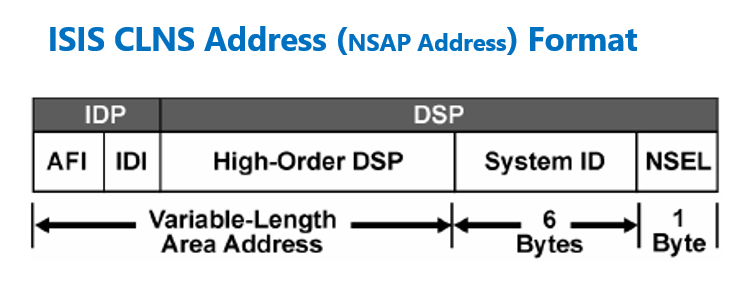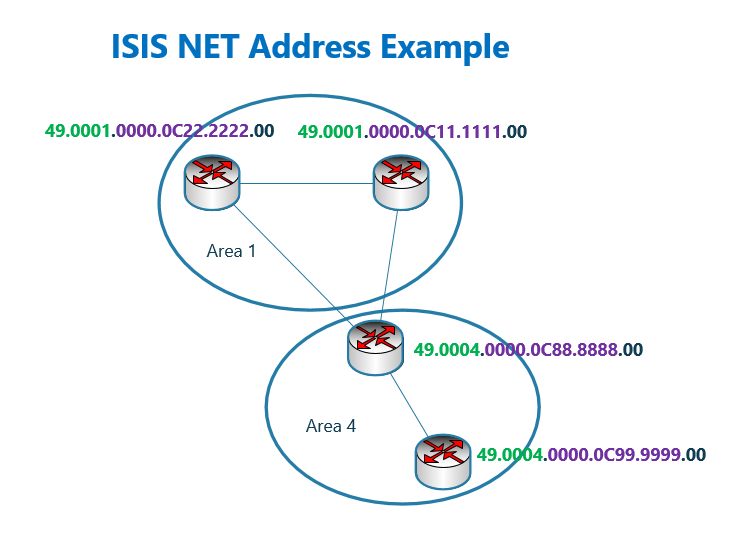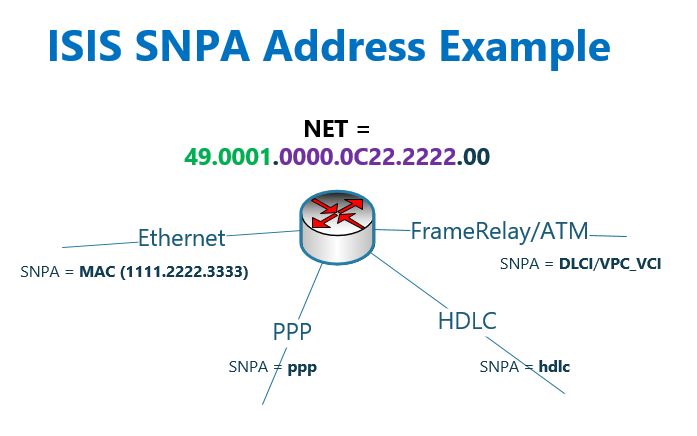ISIS NET Address is what we have to configure when we use ISIS routing protocol in the network.
This is because the ISIS protocol was originally developed for CLNS networks. Although we use IP address to route IP traffic, but ISIS control packets still use CLNS address to communicate with each other.
ISIS NET address is a type of CLNS address that we will discuss in this section.
ISIS Address Format Fundamental and ISIS NET Address
As you know, ISIS protocol was originally developed for CLNS networks, which of course no longer exist today.
Despite the fact that we use ISIS to only route IP traffic, ISIS routers must be addressed with CLNS addresses.
In other words, ISIS routers still need CLNS addresses to form adjacency. Therefore, despite our desire, we have to learn a little about this type of addressing.
Unlike IP addresses, CLNS addresses are not addressed at the interface level, but we assign only one CLNS address to each router.
CLNS network address is called NSAP address. In other words, NSAP address is like IP address, but on CLNS network.
NSAP address is represented in hexadecimal format and has a minimum of 8 bytes (16 hexadecimal digits) and a maximum of 20 bytes (40 hexadecimal digits).
NSAP address consists of three main parts. Its most valuable part is the Area identifier, which is at least 1 and at most 13 bytes. Its middle part is the identifier of the router and is called system-id, and it is always 6 bytes. And finally, its low value part is called NSEL, which is always 1 byte and its value is usually 00.
The NSEL field specifies the different services of the router and is equivalent to the port number in IP networks. In the ISIS routing protocol, we set the value of NSEL field to 00.
An NSAP address whose NSEL value is 00 is also called a NET address. Since in ISIS implementation and addressing routers, the NSEL field always has the value 00, so from now on we will use the word NET address instead of the NSAP address. In the implementation of ISIS, you will also encounter exactly the word, NET address.
NET address must be unique in the entire network.
In this figure, you can see different fields such as AFI, IDI and DSP, which it is better not to think too much about and do not involve yourself in its details. Because if you are using ISIS for IP network routing, knowing these details will not help you either in configuring or in troubleshooting ISIS. Therefore, we ignore these details and simply name them as Area identifier.
ISIS NET address role in Traffic Routing
For each Area, we consider a unique value for the Area field. The Area field is used for routing between areas in the CLNS network. The system-id field is also used for routing inside the Area in CLNS network.
Of course, it is obvious that in IP networks, the IP address is used to route data traffic, and CLNS addresses have no role in routing. But ISIS control traffic is still of this type and that is why it is necessary to use these addresses.
ISIS NET address Example
For a better understanding of ISIS NET address, an example is given here.
There are two Area 1 and Area 4, whose Area numbers are 49.001 and 49.0004, respectively.
Area number is usually considered as 3 bytes, the first byte of which is 49. The number 49 specifies the scope of the addressing system, which means that it is local and internal.
The next 6 bytes or 12 digits are the system-id and it is different for each router and must be unique in the entire network.
The last byte or the last two digits is always 00.
ISIS SNPA address
Other addressing-related terms that you will encounter when implementing or troubleshooting ISIS are SNPA and circuit Id.
- The SNPA address on Ethernet interfaces is equal to the MAC value of that interface.
- For Frame Relay and ATM interfaces, SNPA address is the same as the VC number. In ATM network it is equal to VPI/VCI and in Frame Relay it is equivalent to DLCI address.
- In HDLC and PPP interfaces, SNPA address is the same as the layer 2 protocol name of the interface, HDLC or PPP.
ISIS SNPA address Example
For a better understanding, here is an example topology in which router R1 is connected to three routers R2, R3 and R4 with three different interface types.
At the moment, focus should not to be on how this topology is implemented or configured. The configuration will be shown in the next section.
Running the “show clns neighbors” command on router R1, which displays router R1’s neighbors on the CLNS network, displays the SNPA addresses of all three interfaces.
R1#show clns neighbors
System Id Interface SNPA State Holdtime Type Protocol
R2 Et0/0 aabb.cc00.0200 Up 8 L1 IS-IS
R3 Se2/0 *PPP* Up 29 L1 IS-IS
R4 Se2/1 *HDLC* Up 22 L1 IS-IS
R1#As you can see, the SNPA address on the Ethernet interface is the same as the MAC address. On the PPP interface the word “PPP” and on the HDLC interface the word “HDLC” form the SNPA addresses of the router interfaces.
ISIS Circuit Id
With using ISIS protocol in IP network, the term used to identify each interface in the router is circuit Id.
The NET address is determined for each router, but the term circuit Id is used to identify each of router interfaces in the ISIS protocol.
In order to better remember the meaning of each of the addresses, the following table shows the use of each address separately.
| The Number of Addresses | CLNS Network | ISIS in IP network | |
| Layer 3 Address | one Address for each Router | NSAP Address | NET Address |
| Layer 2 Address | one Address for each Interface | SNPA Address | Circut ID |
How layer 2 address of each interface, or Circuit Id is determined in the ISIS protocol?
- On LAN interfaces, a 1-byte tag is added to the system-id of the DIS router, creating a 7-byte Circuit Id. DIS is equivalent to DR in OSPF. In Cisco routers, instead of system-id, the hostname of the router is used for the circuit Id address.
- In point-to-point interfaces, the Circuit Id address is 1 byte locally significant number, unique for each interface..
According to the previous topology, we enter the “show isis neighbors” command on the R1 router to identify ISIS neighbor routers. In the output, the Circuit Id of the neighboring routers is shown.
R1#show isis neighbors
System Id Type Interface IP Address State Holdtime Circuit Id
R2 L1 Et0/0 10.1.2.2 UP 8 R2.01
R3 L1 Se2/0 10.1.3.3 UP 27 00
R4 L1 Se2/1 10.1.4.4 UP 29 00
R1#
R2#show isis neighbors
System Id Type Interface IP Address State Holdtime Circuit Id
R1 L1 Et0/0 10.1.2.1 UP 25 R2.01
R2#
R3#show isis neighbors
System Id Type Interface IP Address State Holdtime Circuit Id
R1 L1 Se2/0 10.1.3.1 UP 24 00
R3#
R4#show isis neighbors
System Id Type Interface IP Address State Holdtime Circuit Id
R1 L1 Se2/0 10.1.4.1 UP 21 01
R4#
The output of this command is also shown in routers R2, R3 and R4.
If you look carefully, the Circuit Id of both routers R1 and R2 is the same and equal to R2.01. As mentioned earlier, in networks where DIS exists, the value of Circuit Id is calculated from the hostname of the DIS router and not the router itself. Circuit Id of two routers R3 and R4 are also the same, 00 since they are connected with point to point interfaces,



